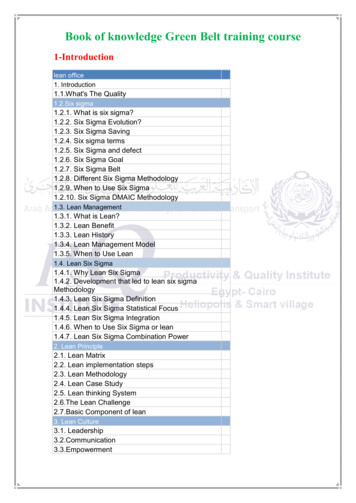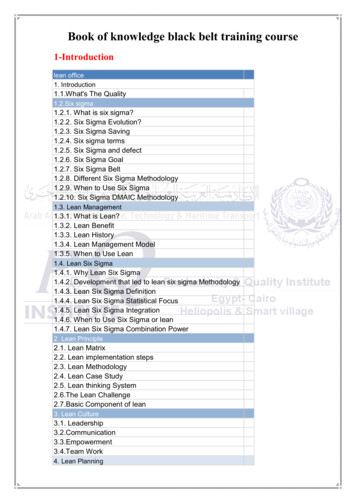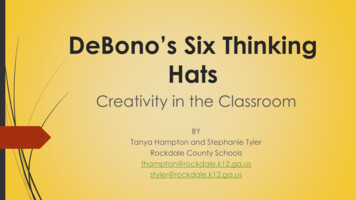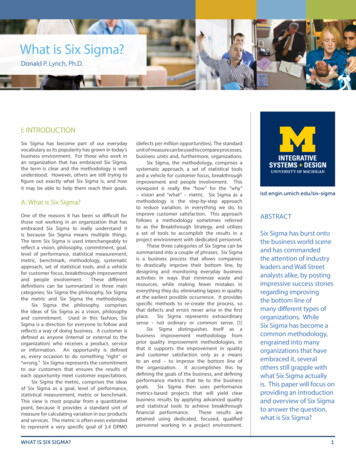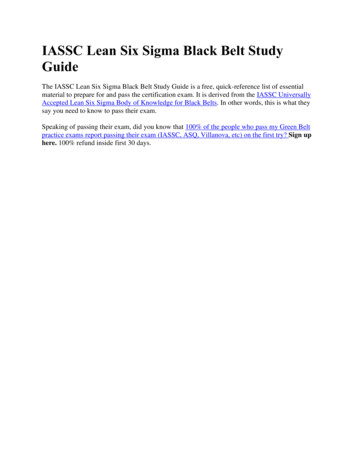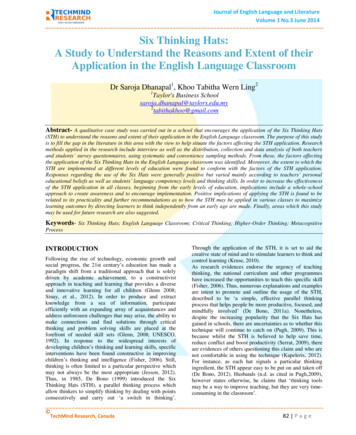
Transcription
Journal of English Language and LiteratureVolume 1 No.3 June 2014Six Thinking Hats:A Study to Understand the Reasons and Extent of theirApplication in the English Language ClassroomDr Saroja Dhanapal1, Khoo Tabitha Wern Ling21Taylor's Business mail.comAbstract- A qualitative case study was carried out in a school that encourages the application of the Six Thinking Hats(STH) to understand the reasons and extent of their application in the English Language classroom. The purpose of this studyis to fill the gap in the literature in this area with the view to help situate the factors affecting the STH application. Researchmethods applied in the research include interview as well as the distribution, collection and data analysis of both teachersand students’ survey questionnaires, using systematic and convenience sampling methods. From these, the factors affectingthe application of the Six Thinking Hats in the English Language classroom was identified. Moreover, the extent to which theSTH are implemented at different levels of education were found to conform with the factors of the STH application.Responses regarding the use of the Six Hats were generally positive but varied mainly according to teachers’ personaleducational beliefs as well as students’ language competency levels and thinking skills. In order to increase the effectivenessof the STH application in all classes, beginning from the early levels of education, implications include a whole-schoolapproach to create awareness and to encourage implementation. Positive implications of applying the STH is found to berelated to its practicality and further recommendations as to how the STH may be applied in various classes to maximizelearning outcomes by directing learners to think independently from an early age are made. Finally, areas which this studymay be used for future research are also suggested.Keywords- Six Thinking Hats; English Language Classroom; Critical Thinking; Higher-Order Thinking; MetacognitiveProcessINTRODUCTIONFollowing the rise of technology, economic growth andsocial progress, the 21st century’s education has made aparadigm shift from a traditional approach that is solelydriven by academic achievement, to a constructivistapproach in teaching and learning that provides a diverseand innovative learning for all children (Glenn 2008;Sinay, et al., 2012). In order to produce and extractknowledge from a sea of information, participateefficiently with an expanding array of acquaintances andaddress unforeseen challenges that may arise, the ability tomake connections and find solutions through criticalthinking and problem solving skills are placed at theforefront of needed skill sets (Glenn, 2008; UNESCO,1992). In response to the widespread interests ofdeveloping children’s thinking and learning skills, specificinterventions have been found constructive in improvingchildren’s thinking and intelligence (Fisher, 2006). Still,thinking is often limited to a particular perspective whichmay not always be the most appropriate (Jesson, 2012).Thus, in 1985, De Bono (1999) introduced the SixThinking Hats (STH), a parallel thinking process whichallow thinkers to simplify thinking by dealing with pointsconsecutively and carry out ‘a switch in thinking’. TechMind Research, CanadaThrough the application of the STH, it is set to aid thecreative state of mind and to stimulate learners to think andcontrol learning (Kruse, 2010).As research evidences endorse the urgency of teachingthinking, the national curriculum and other programmeshave increased the opportunities to teach this specific skill(Fisher, 2006). Thus, numerous explanations and examplesare intent to promote and outline the usage of the STH,described to be ‘a simple, effective parallel thinkingprocess that helps people be more productive, focused, andmindfully involved’ (De Bono, 2011a). Nonetheless,despite the increasing popularity that the Six Hats hasgained in schools, there are uncertainties as to whether thistechnique will continue to catch on (Pugh, 2009). This isbecause whilst the STH is believed to help save time,reduce conflict and boost productivity (Serrat, 2009), thereare evidences of others questioning this claim and who arenot comfortable in using the technique (Kapeleris, 2012).For instance, as each hat signals a particular thinkingingredient, the STH appear easy to be put on and taken off(De Bono, 2012). Husbands (n.d. as cited in Pugh,2009),however states otherwise, he claims that ‘thinking toolsmay be a way to improve teaching, but they are very timeconsuming in the classroom’.82 P a g e
Journal of English Language and LiteratureVolume 1 No.3 June 2014The STH may be tailored to fit learners’ needs in order toproduce tangible results (Jasper, 2006 cited in Al-Bahadli,n.d) and people aver that the STH is easy to employ in theprimary years (Pugh, 2009). These same people, however,claim that the technique may only be incorporated intosubjects by committed teachers in secondary education(Pugh, 2009). Then again, most of the successfulliteratures are found in the secondary and higher level ofeducation with little researches done in primary education.Additionally, much literature on critical thinking andthinking skills tool like the STH, are often seen in theEnvironmental Studies and Sciences subjects, whichrequires problem solving and inquiry based approach(Ballantyne et al., 2001; UNESCO, 1992). Nonetheless,the necessity of incorporating critical thinking into allsubjects, including English, has become increasinglyrecognized to equip learners in developing their thoughts,even before they enter university, as many students todaystruggle to meet this expectation (Hove, 2011; Carmichael,2006).In this 21st Century, the development of thinking skills hasbecome a prominent feature in teaching learners ‘how tothink’. Thinking skills tools such as the Six Thinking Hatsare thus implemented in the classrooms, to equip studentswith the skills needed for metacognitive processes. Inemploying thinking tools into the inquiry-basedclassrooms, teachers and students are set to confront theirown notions and explore new things, instead of learning bynote. As each STH provides a framework for organisedthoughts that may be changed purposefully (Stone, 2005),a more rounded view of a particular task is provided for alllearners to share an equal opportunity, for a joyful andbeneficial learning (Starko, 2010; Al-Bahadli, n.d). Hence,by applying the STH in a whole school approach, not onlymay it be used to enhance inquiry subjects such as Science,but also the English subject which has become morerecognized to require critical and creative thinking.According to Naginder Kaur (2013), one of the manypredicaments faced by language learners at all levels islack of lexical competence, resulting in laggingproficiency levels and inability to relate to the fourlanguage skills and this research advocates the use of sixthinking hats to address the issue.Since this time-tested thinking tool has been proveneffective by leading companies and in schools such as theFranny McAleer’s Group (De Bono, 2012), the purpose ofthis research is not to question but to enhance the usage ofthe Six Thinking Hats in school. This study will thusattempt to identify the factors affecting the application ofthe Six Hats in the English classroom and the extent towhich the STH is applied in the primary and secondaryeducation. In order to value the use of the STH technique,this study will address two objectives. The first objective isto identify the factors affecting the application of the SixThinking Hats in the classroom. Second, is to investigatethe extent to which the Six Thinking Hats are implementedin the classrooms. In the process, recommendations will bemade to schools to enhance the STH usage. Thus, the TechMind Research, Canadafundamental research questions central to this study are:1. What are the factors affecting the application of theSix Thinking Hats in the English Languageclassroom?2. To what extent are the Six Thinking Hatsimplemented in the English Language classroom?The results of the following case study will serve as areference for educators, organizations or individualsinterested in promoting the STH usage in the classroom asfactors affecting its application are identified. Moreover, itwill provide a deeper understanding of how theimplementation of the STH may vary and be used moreeffectively in the English subject. In addition, this studywill generate vital findings for future researches intendedto review the application of the STH for a particular agegroup or strand in English. It will also present importantinformation for researchers interested in investigating STHusage at diverse levels, for a different subject.LITERATURE REVIEWThere has been a rising interest, internationally, in both thedevelopment of learners’ thinking skills and self-initiatedinquiry-based learning (Jones, 2008). In the myriad ofthinking skills tool available, the Six Thinking Hats (STH)has become one of the most prominent thinking tools inthe inquiry classroom (McAleer, 2006). This section willthus discuss the nature of thinking skills and explicate theapplication of the STH.THINKING SKILLSUnlike before, the 21st Century education calls foropportunities that extend beyond the “standard” educationexperiences to equip all students with the skills required tobecome global competent citizens (Sinay et al., 2012).Education, as Scafersman’s (1999) defines, consists of twomain goals that are transmitted to students. The first goal isthe transmitting of subject matter and acquiring of basicknowledge which is known as “what to think”; whilst thesecond goal “how to think” involves critical thinking(Schafersman, 1991). Through the growing awareness ofsocietal change and skills that may no longer be fitting toprepare students for the world beyond school (Fisher,1999), Schafersman (1991) asserts that today’s curriculumthrives towards teaching students how to think.Fisher asserts that ‘the basic premise of a ‘thinking skills’approach to education is that the quality of our lives and ofour learning depends largely on the quality of our thinking’(1999:52). Luterbach and Brown concur in their resultsthrough a Delphi study that thinking skills is a skill all 21stCentury learners should possess (2011 cited in Sinay et al.,2012). Since the attainment of achieving critical thinking isperceived to be of paramount importance, scores ofdefinitions and descriptions have been attained(Carmichael, 2006). While some theories use the terminterchangeably with ‘higher-order thinking skills’(Schafersman, 1991), others believe it to include higherorder thinking skills along with creativity and other83 P a g e
Journal of English Language and LiteratureVolume 1 No.3 June 2014thinking skills (King et al., 1998; Marrapodi, 2003). Thereare also arguments that thinking is a holistic activity(Fisher, 1999). Dewey, however points out that criticalthinking is defined as an active process as its distinguishedelements include metacognition, information processing,analysing and problem solving (cited in Fisher, 1991 andFisher, 1999).TEACHING THINKING SKILLSAs thinking is defined and may be taught through diversemeans, there is no consensus about how thinking should betaught (Aubrey et al., 2012). As a result, there are doubtsas to whether thinking should be taught as a discreteprogramme or through an infusion with a thinkingcurriculum all through various subjects and learning areasof the curriculum, to promote the application of specificskills and strategies (Aubrey et al., 2012). There are alsoqueries as to which grade level would be the optimal agegroup that teachers should begin teaching thinking(Aubrey et al., 2012). Walsh et al. (2007) accentuates thatwhile most literature review on thinking skills have beenfocusing on the upper primary and secondary education,only Taggart et al.’s recent research has filled the gap inthe early years (2005 cited in Walsh et al., 2007).Nonetheless, according to Lai’s (2011) research report,empirical research suggests that the development of criticalthinking competencies commence in an early age of even 3to 4 years old but he went on to assert that even ‘adultsoften exhibit deficient reasoning’ (Lai, 2011).Thus, while routine teaching is essential for earlydevelopment skills, the most powerful learningenvironment to develop thinking is when time andopportunity is given for learners’ discussion of theirthinking process (Fisher, 1999). This is to allow learners tomake meaning, as Fisher (1999) realizes that the mainelement of high quality thinking is meaning-making. Thesignificance of this is emphasised by Boyer (1995) of aneducated person – that is one who is guided to understandconnections between things. So, by equipping learnerswith the necessary thinking skills tools, by the age ofadolescence, it is hoped that the thinking skills toolsavailable may be fully utilized to its maximum worth for ahigher level of evaluation and creativity. This is vital as inthe intellectual development, adolescence is the period of‘maximum growth and development with regard to mentalfunctioning’ (Singh, 2010:53). Walsh et. al.’s findingsconcluded that ‘practitioners can play a salient part in thedevelopment of children’s thinking, if the appropriateteaching strategies are used’ (2007:55). Thus even as theSTH technique is ‘adapted to suit the age and interests ofparticular groups of children’ (Smith, 2010), it is importantthat time is allocated and emphasis is placed to develop theinterests in the technique (Al-Bahadli, n.d).“The STH Technique can be applied to most topics,problems or activities” and it is not compulsory to applyall hats for a given situation; neither do the hats have to beset in a particular order (Al-Bahadli, n.d). Several casestudies from the De Bono group and testimonials fromschools and leading companies have thus proved the STHto be an effective strategy for thinking (De Bono, 2012).Similar indications were noted by Horsfall and Bennett’sstudy among a Year 4 class, that open questioning (asunderpinned in the STH technique) ensures improvementin speaking and listening skills, develops effectivecooperative work and increase motivation (2005 cited inWalsh et al., 2007). In addition, Al-Bahadli’s (n.d) studyhas elucidated positive impact on college students’performance in composition writing. Consequently, AlBahadli (n.d) recommends that thinking skills be taught aspart of the educational system and English curriculum.SIX THINKING HATSDe Bono (2011b) warns that in growing up, prescriptiveeducation pushes children through a series of educationalnarrow gates, reducing the mind’s capacity to exercise‘possibility thinking’.FIGURE 1. Six Thinking Hats (Kruse, 2010:71) TechMind Research, Canada84 P a g e
Journal of English Language and LiteratureVolume 1 No.3 June 2014Thus, as we move towards a new era of creativity and ofrapid growth and changes, the call to put on our Six Hats isurged to bridge the gap between cultures, as it promotescollaborative thinking, sharpens focus, facilitatescommunication, enables thorough evaluation, improvesexploration and fosters creativity and innovation (Serrat,2009). The effect of this is by considering a specificproblem from various angles (Jesson, 2012).As shown in Figure 1, the white hat calls for informationwhile the red hat provides opportunity for expressions(Kruse, 2010). Just as the sun shines brightly, the yellowhat symbolizes the positive points, whereas the black hatwhich is the negative hat, involves detecting problems andcritical judgement (De Bono, 2011a). Then there is thegreen and blue hat which focuses on creativity andmanages the thinking process (De Bono, 2011a). Thus, theSTH technique is important as it allows learners to becomemore self-directed even as more information is gained(Starko, 2010; Stone, 2005). In the process of developingbeyond a broad view of the purposes of education anddeveloping ‘the virtues of affiliation to truth, honesty ofexpression and a respect for others’ (Fisher, 1999:55),users may develop a sense of oneself as a thinker andlearner. Hence, Lawrence states that thoughts or thinking‘is the ‘wholeness’ of a person, ‘whole attending’” (1964cited in Fisher, 1999:53).In applying the Six Hats, Gonzalez (2001) states that thereare no restrictions in its usage as the main idea is toprovide a focused direction for individuals as well asgroups. Similar to drawing a map, users may take decisionof a presented case by investigating the subject fromdifferent angles before choosing the route (Granica, 1986).The person holding on to the blue hat leads the discussionand takes responsibility for organising the thinking processby stating the case at the beginning and then directing thegroup to the thinking process of one particular hat (Kruse,2010).Within a group setting, all members must hence be willingto work towards the same direction and think in the samemode throughout a session (Gonzalez, 2001). Ciardiellostates that ‘the process of generating questions depends onthe ability to identify different cognitive levels ofquestions’ (1998 cited in Koechlin & Zwaan, 2006:32).Amidst of abundant types of questions and purposesbehind each inquiry, learners must learn to uncover somepatterns for themselves by gaining the skill to classifyquestions and effectively identify the appropriate actiontowards the source of the answer (Koechlin & Zwaan,2006). Hence, as each hat provides a framework fororganized thinking and supplies cues for open-endedresponses, the STH technique is encouraged to supportboth the teacher and class to think creatively in tacklingproblems (Jesson, 2012; Stone, 2005).METHODOLOGYAs the development of thinking skills is significant from ayoung age, this study has chosen to look into the usage of TechMind Research, Canadathe Six Thinking Hats to develop thinking skills, across thedifferent levels of education, in the English Languageclassroom. A qualitative case study was carried out toexamine the decisions and behaviour of a particular groupof teachers and students, within a single organizationsetting, subject and use of the STH tool in detail. Thepurpose of conducting a case study is to gain an in-depthstudy of an individual program, activity, people or group,as explicated by Mertler (2006). The essence of qualitativeresearch is that it allows flexibility in understanding thecomplex reality of a given situation through expressionand explanation of opinions, feelings, and experience,which may provide implication to any quantitative data aswell (Mack et al., 2005; McMillan & Weyers, 2010).Through the qualitative results obtained, a detailedanalysis of the factors affecting the STH application andthe extent of its implementation may be made.The main participants in this study are the teachers withcorroboration from students’ responses. Since the researchrequires a certain amount of comparison between bothsecondary and primary education, selected teachers andstudents from all grade levels were involved. Through asystematic sampling, every one of the English teachersteaching the secondary education was chosen, irrespectiveof their age and gender. Conversely, as the number ofEnglish primary teachers was more than two times theEnglish teachers in secondary school, only two Englishteachers from each primary grade levels were selectedthrough convenience sampling, except for Crèche whichhas only one teacher. Additionally, in order to balance thenumber, two English teachers from IBDP (Diploma level)who also teach the secondary classes participated. As forthe sampling of two students from every grade level,convenience sampling was used for easy accessibility(Walliman & Buckler, 2008). The school principal andacademic director were included in the research usingpurposive sampling, as it is believed that they have goodknowledge of the processes and system of the school.The data collection methods applied in this study consistsof interview and survey questions. While the interviewprovides no more than qualitative data, the surveyquestionnaires consist of both qualitative and quantitativedata, to imply some form of magnitude throughmeasurement in numerical form (Walliman & Buckler,2008). So as to understand the school’s intention ofcarrying out the Six Thinking Hats, a template containingthree specific set of questions were designed. The reasonbehind the structured interviews is to allow easycomparison between the principal and academic director’sresponse. Although questions in the teachers and students’survey questionnaires differed, questions designed for bothgroups comprised of three main sections: Part A whichenquires the participants’ background; Part B enquires theparticipants’ knowledge of the STH; and Part C enquiresthe application of the Six Hats. Using the answers fromPart A, an ordinal analysis was carried out, showing thedifferent levels of education. The close-ended questions inPart B used a Likert scale to evaluate the participants’82 P a g e
Journal of English Language and LiteratureVolume 1 No.3 June 2014responses from ‘not at all’ to ‘very much so’. Using theresults from Part B, a correlation method was used todescribe and analyse the relationship between variables(McMillian & Weyers, 2010). Part C, on the other hand,contained open-ended questions, which enriched the studywith authentic quotes representing the diverse views ofvarious groups. Prior to the interviews and handing out ofsurvey questionnaires, participants were informed aboutthe purpose of the study and assured that identities wouldbe kept anonymous. To ensure validity and reliability, atriangulation process by collecting data through severalsources were done for research analysis, as Mills statesthat ‘researchers should not rely on any single source ofdata, interview, observation, or instrument’ (2003:52).THEORETICAL FRAMEWORKAs this case study will look at the STH applicationthroughout primary and secondary education, De Bono’s(2004) Six Thinking Hats for the Primary Years Educationand the Secondary Years Education have been adapted toform the theoretical framework of this study:FIGURE 2. Theoretical Framework (De Bono 2004)Each of the Six Hats is represented by six distinctivecolours, specifying a distinct mode of thinking (Stone,2005). The STH concept has two central intentions; tosimplify the thoughts by drawing focus on one specificaspect and allowing a variation in thinking (Granica,1986). As such, questions were developed for the Primaryand Secondary Year educations, according to the mode ofeach hat, as shown in Figure 1 to assist learners insharpening their focus.FINDINGS AND DISCUSSIONThe following section will synthesise the findings from alldata collection methods, to discuss the factors affecting theapplication of the Six Thinking Hats and the extent towhich the STH are implemented in the English Languageclassroom. TechMind Research, HCLASSROOMBased on the interviews, it is adhered that the STH is notthe main thinking skills tool used in the school, but iswholly encouraged to direct students in an orderly way ofthinking. The main intention of this is to obtain higherorder thinking skills and while other thinking skills toolmay be applied in the classroom, the STH was deemed tobe the easiest and fastest way to help studentscompartmentalise their thoughts because of its simplicity.In analyzing the responses of the STH applicants in theEnglish classroom, various constraints and challengesfaced in applying the STH were identified and categorized83 P a g e
Journal of English Language and LiteratureVolume 1 No.3 June 2014into three main points: students’ knowledge andunderstanding of the STH; teachers’ knowledge andunderstanding of the STH; and time constraint andpreferences in implementing the STH.STUDENTS’KNOWLEDGEUNDERSTANDING OF THE STHANDIn comparing the teachers’ responses, the concern overstudents’ maturity levels and questioning skills is found tobe a more critical matter in the English primary classroom.The first teacher teaching Reception explained thatbecause the students are very young, guidance is alwaysneeded to support the children’s learning. While thematurity level of students’ cannot be measured, Figure 3shows the knowledge and confidence level of students inapplying the STH from Crèche till Grade 11. The letter“G” before the numbers within the figure indicates thegrade level of the students. For instance, G5 represents thestudent in grade 5.FIGURE 3. Students’ Knowledge and Confidence in STH Application at Different Levels of EducationEven though the knowledge of STH application shows agradual increase over the different levels of education, theconfidence level of students in application shows a morerapid increase. While most of the students in the lowerprimary (crèche to grade 2) were unable to clarify if theyare comfortable with the STH or if it is found useful tothem, students from the upper primary (grade 3 to 6) andsecondary school showed more ease in applying them. Thesecondary school students were even able to identify theimportance of it for organisation and to support thinking,to make concepts easier for understanding and foranalysing.FIGURE 4. Students’ Knowledge and Confidence in STH Application over the Number of Years in the School TechMind Research, Canada83 P a g e
Journal of English Language and LiteratureVolume 1 No.3 June 2014During the interview, the academic director mentioned thatthe implementation of the STH was made compulsory 8years ago. In order to evaluate the effectiveness ofembedding the STH, Figure 4 was constructed to comparethe average percentage scale of students’ knowledge andconfidence in STH application in relation to the number ofyears that each student has studied in the school.Irrespective of the grade level (as shown in the bracketsbeside the number of years each child has been in school),a higher confidence and knowledge level is found amongthose who have studied in the school for about 12 years,compared to those who entered later. What is fascinating,however, is that the gap between knowledge andconfidence level is bigger in those who have been in theschool for a longer period of time. In comparing Figure 3with Figure 2, the succession in Figure 2 shows a higherincrease in both students’ knowledge and confidence level.In fact, students in the higher level of education showedgreater confidence in applying the STH compared tostudents from the lower grades (Figure 2). Based on theresults, it is thus probable that the number of years taken topractice using the STH is not so significant, as secondaryschool students are deemed to have a better grasp and canrelate better to the STH, though with less practice,compared to the younger aged students.TEACHERS’KNOWLEDGEUNDERSTANDING OF THE STHANDYet, despite the capability which the older students possessto think on their own, the main issue faced by upperprimary and secondary education teachers is not gettingstudents to think, but finding activities that can connect tothe STH. This may be the cause of teacher competency, asshown in Figure 5, which presents the relation between theknowledge and confidence level of teachers’ teachingEnglish to Crèche all the way to IBDP (Diploma Level), inapplying the STH.FIGURE 5. Comparisons of Teachers’ Knowledge and Confidence in STH ApplicationWhile the primary school teachers seem to have a goodknowledge of the STH, the knowledge and confidencelevel shows a decline in the higher levels of education.Interestingly, while ‘knowledge of applying the STH’shows a decline of approximately 8%, teachers’confidence in applying the STH is impervious with agradual decrease of only 2% or less. This has consequentlyled to the query of whether prior training on the STHaffects teachers’ implementation. In Figure 6, the bar chartmeasures the percentage of teachers who have and havenot attended training on the STH from the lower andsecondary educational level.FIGURE 6: Teachers who have and have not attended training TechMind Research, Canada82 P a g e
Journal of English Language and LiteratureVolume 1 No.3 June 2014Whereas none of the secondary level teachers hadparticipated in any training, all of the teachers who hadattended prior training come from primary education level,making up almost two-third of the teachers in the primarylevel.Figure 7, compares the estimated values ofknowledge and confidence of teachers who have and havenot attended any STH trainings, from the lower andsecondary education level.FIGURE 7: Comparisons of STH Applicators who have and have not attend trainingAs seen in Figure 7, a higher degree of knowledge andconfidence is found among those who have attendedtraining before. Consequently, the knowledge andconfidence of STH application is correlated to attendingSTH trainings. Based on the findings, not only is thesecond grade 5 teacher not able to fully understand theconcept; but this is also equally true for his/her students aswell. Hence, the STH is not implemented as effectively ashow he/she wanted to.Then again, despite having less knowledge about the STH,upper primary and secondary school teachers show ahigher level of knowledge and confidence (Figure 7) aswell as more frequency and ease in implementing severalhats at the same time. This is noted as in Figure 5, theconfidence level of secondary education teachers who havenever attended any training is more or less parallel to theprimary education teachers. A reason for this may bebecause the older students are able to implement the STHmore efficiently, which lessens the burden of the teachers.On the other hand, the low level of confidence in the lowerlevels of education (see Figure 5) is also believed to belinked to the practice of implementation and students’competency level.Then again, in rev
Thinking Hats in the classroom. Second, is to investigate the extent to which the Six Thinking Hats are implemented in the classrooms. In the process, recommendations will be made to schools to enhance the STH usage. Thus, the fundamental research questions central to this study are:


